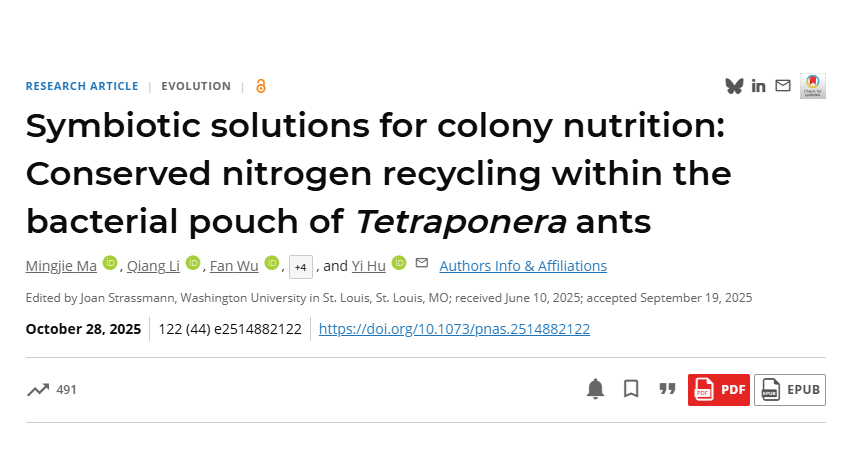Professor Hu Yi's research group from the College of Life Sciences published an article in PNAS
Recently, the research group led by Professor Hu Yi from the College of Life Sciences, Beijing Normal University, published a paper titled "Symbiotic solutions for colony nutrition: Conserved nitrogen recycling within the bacterial pouch of Tetraponera ants" in PNAS.
In a clade of herbivorous Tetraponera ants, the team reveal a specialized organ—a bacterial pouch unique among Hymenoptera—that enables colony-wide nutritional symbiosis. The bacterial symbionts in workers' pouches recycle nitrogenous waste and produce essential amino acids, sustaining workers themselves as well as larvae in nitrogen-poor environments. Disrupting this symbiosis impairs colony growth and fitness, demonstrating that microbial functions transcend individual hosts to stabilize superorganismal health. This places Tetraponera among the few social insect taxa with microbial mediation of dietary constraints experimentally proven. By elucidating convergent evolutionary strategies in herbivorous ants, the team redefine symbiotic partnerships as colony-level adaptations, reshaping frameworks for host–microbe interactions in social organisms.

Abstract:
While microbial symbioses are fundamental to the nutrition of many animal groups, current paradigms focus on symbiont functions at the host individual level. It remains unclear whether microbial symbioses can sustain colony-level fitness in social insects, whose ecological success depends on nutrient coordination across castes. Here, we investigate the specialized bacterial pouch, a symbiont-containing organ present exclusively in adult workers of Tetraponera nigra-group ants, revealing its crucial role in colony-wide nutrient provisioning. Using a combination of microscopy, amplicon and metagenomic sequencing, and N-urea feeding experiments on four species in the group, we show that its adult-specific pouch-associated microbiota, primarily Tokpelaia, recycle nitrogen from urea and convert it into amino acids which are provisioned to adult workers and developing larvae. Disruption of this nitrogen-recycling symbiosis severely impairs larval growth and overall colony fitness. Our results show how caste-restricted microbial organs can centralize metabolic functions at the colony level, challenging individual-centric paradigms of host–microbe mutualism and providing insights into the pivotal role of microbial symbionts in superorganismal adaptation to nutritional constraints.


